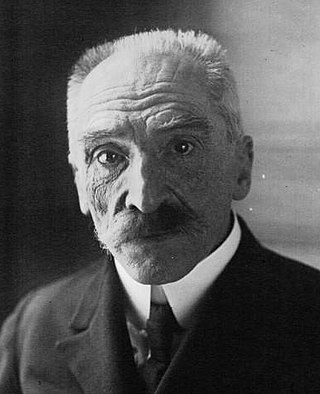
Édouard Estaunié was a French novelist. Estaunié trained as a scientist and engineer, working at the Post and Telegraph service and training further in Holland, before turning to the novel in 1891. In 1904, he devised the word "telecommunication" in his Traité pratique de télécommunication électrique. He was elected to the Académie française in 1923. He was also a reviewer, critic, and homme de lettres as well as a novelist.

A chute is a vertical or inclined plane, channel, or passage through which objects are moved by means of gravity.

The Pic du Midi d'Ossau is a mountain rising above the Ossau Valley in the French Pyrenees. Despite possessing neither a glacier nor, in the context of the range, a particularly high summit, its distinctive shape makes it a symbol of the French side of the Pyrenees. This familiar shape also makes it easily recognisable from afar, and it is particularly distinctive from the Boulevard des Pyrénées in Pau, some 55 km to the north.

Nicolas Le Camus de Mézières was a French architect and theoretician. He was born and died in Paris. He published several works on architectural and related subjects, including Architecture of Expression, and The Theatre of Desire at the End of the Ancien Régime; Or, The Analogy of Fiction with Architectural Innovation.

Eaux-Bonnes is a commune in the Pyrénées-Atlantiques department in south-western France.

The arrondissement of Oloron-Sainte-Marie is an arrondissement of France in the Pyrénées-Atlantiques department in the Nouvelle-Aquitaine region. It has 155 communes. Its population is 72,504 (2016), and its area is 2,828.2 km2 (1,092.0 sq mi).
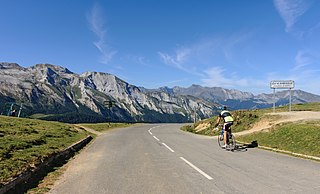
The Col d'Aubisque is a mountain pass in the Pyrenees 30 km (19 mi) south of Tarbes and Pau in the department of the Pyrénées-Atlantiques, in the Aquitaine region of France.

The Diocese of Bayonne, Lescar, and Oloron, commonly Diocese of Bayonne, is a Latin Church ecclesiastical territory or diocese of the Catholic Church in France. It is a suffragan diocese in the ecclesiastical province of the metropolitan Archdiocese of Bordeaux. The diocese comprises the département of Pyrénées-Atlantiques, in the région of Nouvelle-Aquitaine.
Charles Henri Marie Flahault was a French botanist, among the early pioneers of phytogeography, phytosociology, and forest ecology. The word relevé for a plant community sample is his invention.

Jean Paul Louis François Édouard Leuge-Dulaurier was a French Orientalist, Armenian studies scholar and Egyptologist.
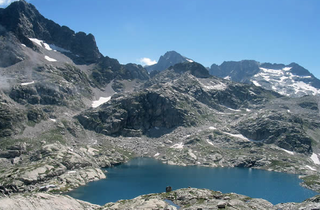
Laruns is a commune in the Pyrénées-Atlantiques department in south-western France.

Eaux-Chaudes is a spa in the valley of the Gave d'Ossau in the French Pyrenees.
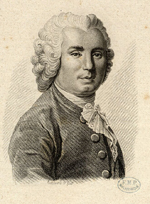
Théophile de Bordeu was a French physician.

The Saboulin Bollena family is one of the oldest French aristocratic families, from the old feudal nobility of Provence.
The Sovereign Council of Navarre and Béarn was created by Henry II of Navarre at the Château de Pau on 13 June 1519, replacing the Cour Majour which was disbanded in 1490.
The canton of Oloron-Sainte-Marie-2 is an administrative division of the Pyrénées-Atlantiques department, southwestern France. It was created at the French canton reorganisation which came into effect in March 2015. Its seat is in Oloron-Sainte-Marie.
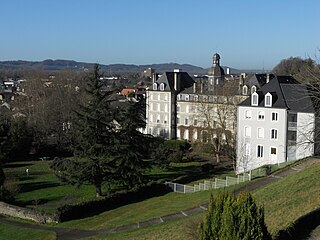
The lycée Jacques-Monod is a French institute of secondary and higher education located in Lescar (Pyrénées-Atlantiques). It has more than 800 students, and is located in a building with a rich history. Its first use was as a college (1624-1793) run by the Barnabites, a Catholic religious order. After the French Revolution and the closure of many religious institutions, it was a military hospital (1794/5), and then a teacher training college (1845-1978). It became the independent lycée Jacques-Monod in 1992.

Eugène de Malbos was a French Romantic painter known for his lithographs of the Pyrenees.
Gaston Raynaud was a French philologist and librarian.
The Treaties of Good Correspondence were agreements drawn up under the Ancien Régime by the Basques of France and those of Spain, designed to guarantee the continuity of their economic relations despite the wars between the two countries.


















